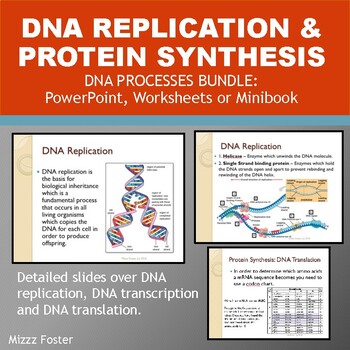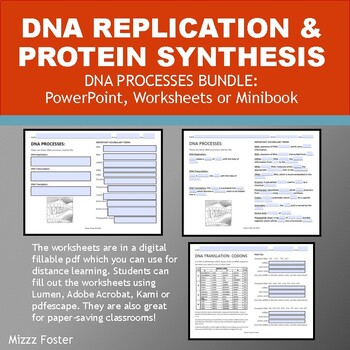DNA Replication and Protein Synthesis: PowerPoint and Notes (Digital & Print)
- Zip
What educators are saying
Also included in
- This HUGE bundle covers an entire year of Biology plus more. The PowerPoints are accompanied by differentiated guided notes covering CHNOPS, biochemistry, cells, cell processes, DNA replication, transcription, translation, genetics, homeostasis, symbiosis, evolution, population genetics, taxonomy, ePrice $179.99Original Price $230.00Save $50.01
- Bundle DescriptionThis HUGE bundle covers an entire year of Biology plus more. The PowerPoints are accompanied by differentiated guided notes covering CHNOPS, biochemistry, cells, cell processes, DNA replication, transcription, translation, genetics, homeostasis, symbiosis, evolution, population genPrice $249.99Original Price $330.90Save $80.91
Description
DNA Replication and Protein Synthesis: PowerPoint, Worksheets, or Minibook comes with one PowerPoint presentation, two differentiated sets of Guided Notes in Worksheet, and mini-book styles. The guided notes are in print and digital formats. Both styles complement distance, hybrid, and traditional learning. The digital worksheet is great for online platforms such as Google Classroom, Schoology, or others. The digital fillable pdf form can be filled out using Adobe Acrobat, Lumen, Kami, or other free pdf-editing applications.
This bundle covers DNA replication and protein synthesis in detail with a Guided Notes PowerPoint presentation and a choice of student worksheets or mini-book to glue into interactive notebooks.
There are two forms of student-guided notes. the regular student notes allow students to write their notes verbatim or in their own words. The modified notes are fill-in-the-blank style for students with IEP, 504, or handwriting difficulties. The fill-in-the-blank notes are also good for when you are in a time crunch and need to move through the material quickly.
Students will cover DNA replication in detail with all the enzymes such as polymerases and helicase. Students have diagrams to color and questions to answer. Complimentary DNA base pairing is also reviewed.
Students will also learn about protein synthesis; DNA transcription and DNA translation. Again the student worksheets follow right along and have labeling and questions for the students to answer. Students will learn how to cover template DNA into an mRNA and from mRNA to codons and finally amino acids. There are practice problems for students to complete.
Related Products:
DNA Replication & Protein Synthesis: Transcription, Translation Coloring Sheets
DNA Processes: DNA Replication and Protein Synthesis Worksheets with Key
DNA Processes: DNA Replication, DNA Transcription, DNA Translation PowerPoint
GREAT FOR ANY STATE!
Texas Biology TEKS
(5) Science concepts. The student knows how an organism grows and the importance of cell differentiation. The student is expected to:
(A) describe the stages of the cell cycle, including deoxyribonucleic acid (DNA) replication and mitosis, and the importance of the cell cycle to the growth of organisms;
(C) describe the roles of DNA, ribonucleic acid (RNA), and environmental factors in cell differentiation; and
(6) Science concepts. The student knows the mechanisms of genetics, including the role of nucleic acids and the principles of Mendelian Genetics. The student is expected to:
(A) identify components of DNA, and describe how information for specifying the traits of an organism is carried in the DNA;
(B) recognize that components that make up the genetic code are common to all organisms;
(C) explain the purpose and process of transcription and translation using models of DNA and RNA;
NEXT GENERATION SCIENCE STANDARDS
HS-LS3-1. Ask questions to clarify relationships about the role of DNA and chromosomes in coding the instructions for characteristic traits passed from parents to offspring.
HS-LS1-1. Construct an explanation based on evidence for how the structure of DNA determines the structure of proteins which carry out the essential functions of life through systems of specialized cells.







